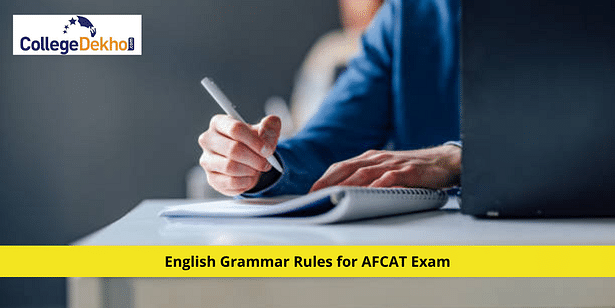
The Air Force Common Admission Test, also known as AFCAT, is an examination that is extremely competitive and is taken by candidates who want to become officers in the Indian Air Force. English Language is one of the most important sections of the AFCAT exam. To excel in this section, you must have a solid understanding of English grammar rules. Applicants from all academic fields who received at least 60% in both Physics and Mathematics in their 10+2 coursework and who are Indian citizens are eligible to apply for this graduate-level exam.
Further, English for AFCAT is essential for success on the test. The person taking the exam must be proficient in English because it is the language medium for this online computer-based test. Most test takers find it difficult to earn a high score in the AFCAT English section. In this comprehensive guide, we will examine the fundamental English grammar rules that every AFCAT aspirant should be familiar with. It will help you boost your confidence and performance on the AFCAT English section, whether you are a beginner or need a refresher.
Parts of Speech
Composing grammatically correct sentences requires an understanding of the various parts of speech. Here is a breakdown of the major parts of speech:
Noun
A noun is a word that represents a person, place, thing, or idea. Nouns can be classified as common or proper and can be singular or plural.
Example: The pilot (common noun) flew an aircraft (common noun).
Pronoun
Pronouns replace nouns in sentences to avoid repetition. Common pronouns include he, she, it, they, and we.
Example: She is a skilled pilot. She flies aircraft.
Verb
Verbs are action words that show what someone or something is doing.
Example: The pilot (noun) flies (verb) the aircraft (noun).
Adjective
Adjectives modify nouns and provide more information about them. They answer questions like "What kind?" or "Which one?"
Example: The fast (adjective) aircraft (noun) soared through the sky.
Adverb
Adverbs modify verbs, adjectives, or other adverbs. They provide more details about how, when, where, and to what extent an action occurs.
Example: The pilot flew the aircraft extremely (adverb) skillfully (adverb).
Preposition
Prepositions show the relationship between nouns or pronouns and other words in a sentence.
Example: The aircraft flew above (preposition) the clouds.
Conjunction
Conjunctions connect words, phrases, or clauses within a sentence.
Example: The pilot and the co-pilot checked the aircraft before takeoff.
Interjection
Interjections are short, exclamatory words or phrases used to express strong emotions.
Example: Wow! That aircraft is impressive.
You may also want to check out these related reads:
Subject-Verb Agreement
For constructing grammatically correct sentences, subject-verb agreement is essential. A sentence's verb and subject must agree in number (singular or plural). Listed below are some reference examples:
Singular subjects require singular verbs.
Example:The pilot flies the aircraft.
Plural subjects require plural verbs.
Example: The pilots fly the aircraft.
Compound subjects (subjects joined by "and") usually require plural verbs.
Example: The pilot and the co-pilot fly the aircraft.
When the subject is collective (a group acting as one unit), a singular verb is used.
Example: The team flies the aircraft.
Tenses
In a sentence, tenses indicate the timing of an action. There are three main tenses in English: past, present, and future, each with a variety of forms. The following table shows the same along with a brief description and example:
Tense | Description | Example |
|---|---|---|
Present | Used for actions happening now or regularly | The pilot flies the aircraft. |
Past | Used for actions that have already happened | The pilot flew the aircraft. |
Future | Used for actions that will happen in the future | The pilot will fly the aircraft. |
Perfect Tenses | Indicate actions that were completed at a specific time or before another action | The pilot has flown the aircraft. |
Continuous/Progressive Tenses | Indicate ongoing or incomplete actions | The pilot is flying the aircraft. |
Perfect Continuous Tenses | Combine perfect and continuous aspects to show an action that started in the past, continued, and is relevant to the present | The pilot has been flying the aircraft for hours. |
Articles
Articles (a, an, the) are used to limit or specify nouns. Understanding when and how to use them is crucial for clear sentence construction. Here are some examples:
"A" and "an" are indefinite articles used before singular nouns.
Example: A pilot flies an aircraft.
"The" is the definite article used before specific nouns.
Example: The pilot flies the aircraft.
Active and Passive Voice
In the active voice, the subject performs the action, while in the passive voice, the subject receives the action. Active voice is usually preferred for its clarity and directness.
Active Voice Example: The pilot flew the aircraft.
Passive Voice Example: The aircraft was flown by the pilot.
Related Reads:
Direct and Indirect Speech
Direct speech involves quoting someone's words verbatim, while indirect speech reports what someone said without quoting them directly. When converting direct speech to indirect speech, it is essential to change pronouns, tense, and other elements accordingly.
Direct Speech Example: He said, "I will fly the aircraft".
Indirect Speech Example: He said that he would fly the aircraft.
Sentence Structure
Understanding sentence structure facilitates the construction of grammatically correct and comprehensible sentences. Common sentence structures are listed in the following table:
Sentences Type | Description | Example |
|---|---|---|
Simple Sentences | Contain one independent clause | The pilot flew the aircraft. |
Compound Sentences | Combine two or more independent clauses with coordinating conjunctions (and, but, or) or semicolons | The pilot flew the aircraft, and the co-pilot monitored the instruments. |
Complex Sentences | Contain one independent clause and at least one dependent clause | While the pilot flew the aircraft, the co-pilot monitored the instruments. |
Compound-Complex Sentences | Combine two or more independent clauses with at least one dependent clause | The pilot flew the aircraft, and the co-pilot monitored the instruments while the ground crew prepared for landing. |
Punctuation
The use of proper punctuation enhances the readability of your writing. These are some essential punctuation marks:
Period (.)
Used to end declarative sentences.
Example: The aircraft is ready.
Question Mark (?)
Used to end interrogative sentences.
Example: Is the aircraft ready?
Exclamation Mark (!)
Used to indicate strong emotions or exclamatory sentences.
Example: What a fantastic aircraft!
Comma (,)
Used to separate items in a list, set off introductory phrases, and separate clauses in compound sentences.
Example: The pilot, co-pilot, and ground crew work together.
Colon (:)
Used to introduce a list, explanation, or quotation.
Example: The aircraft has many features: speed, agility, and reliability.
Semicolon (;)
Used to join closely related independent clauses.
Example: The pilot is skilled; the co-pilot is experienced.
Apostrophe (')
Used to indicate possession or contraction.
Example: The pilot's skills are impressive. (possession)
Quotation Marks (" ")
Used to enclose direct speech or titles of short works.
Example: The instructor said, "Stay focused".
Related Reads:
Articles and Determiners
To specify or limit nouns, articles (a, an, the) and determiners (words such as some, any, many) are used.
Definite Article "The"
Used before specific nouns.
Example: The aircraft is impressive.
Indefinite Article "A" or "An"
Used before nonspecific nouns.
Example: A pilot needs training.
Demonstrative Determiners (This, These, That, Those)
Indicate specific nouns.
Example: This aircraft is modern.
Quantifiers (Some, Any, Many, Few)
Indicate the quantity of a noun.
Example: Many pilots attend the training.
Modifiers and Phrases
Modifiers and phrases add depth and detail to sentences. Understanding how to use them correctly is essential. The table below shows the same along with a brief description and example:
Type | Description | Example |
|---|---|---|
Adjectives | Modify nouns and answer questions like "What kind?" or "Which one?" | The sleek aircraft is fast. |
Adverbs | Modify verbs, adjectives, or other adverbs and provide more information. | The pilot flew the aircraft extremely skillfully. |
Prepositional Phrases | Begin with a preposition and provide additional information about location, time, or direction. | The aircraft flew above the clouds. |
Participial Phrases | Begin with a participle (usually ending in -ed or -ing) and provide information about the subject. | The pilot, exhausted from the long flight, landed safely. |
Gerund Phrases | Begin with a gerund (verb + -ing) and function as nouns. | Flying the aircraft is his passion. |
Sentence Types
When writing, it is helpful to employ a variety of sentence types for different purposes. Having a good understanding of them is beneficial to having effective communication. The following table shows the same along with a brief description and example:
Sentence Type | Description | Example |
|---|---|---|
Declarative Sentences | Make statements or convey information. | The aircraft is ready for takeoff. |
Interrogative Sentences | Ask questions. | Is the aircraft ready for takeoff? |
Imperative Sentences | Give commands or make requests. | Prepare the aircraft for takeoff. |
Exclamatory Sentences | Express strong emotions or exclamations. | What an incredible aircraft! |
Conditional Sentences
Conditional sentences express a condition and the likely outcome of it. They typically have an "if" clause and a main clause as their structural components. The following table shows the same along with a brief description and example:
Sentence Type | Description | Example |
|---|---|---|
Zero Conditional | Expresses general truths or facts. | If you heat water to 100 degrees Celsius, it boils. |
First Conditional | Expresses real or possible future situations. | If the weather is clear, the aircraft will take off. |
Second Conditional | Expresses unreal or hypothetical situations in the present or future. | If I were a pilot, I would fly the aircraft. |
Third Conditional | Expresses unreal or hypothetical situations in the past. | If he had studied harder, he would have become a pilot. |
Relative Clauses
The use of relative clauses in a sentence adds new information to an existing understanding of a noun. They are presented to the reader by relative pronouns, such as who, which, and that.
Example: The pilot who flew the aircraft is experienced.
Parallelism
A series of words, phrases, or clauses that have the same grammatical structure as one another are said to have parallelism. It creates balance and clarity in sentences.
Example: The pilot enjoys flying, training, and maintaining aircraft.
Subject-Verb-Object (SVO) Structure
The SVO structure is a fundamental pattern for the construction of sentences in the English language. The sentence contains a subject, a verb, and an object.
Example: The pilot (subject) flew (verb) the aircraft (object).
Common Errors to Avoid
To excel in the AFCAT English section, it is crucial to recognise and avoid common grammatical errors. Some of these errors include:
Subject-verb disagreement: Ensure that the verb matches the subject in number.
Misplaced modifiers: Place modifiers (adjectives or adverbs) near the word they modify.
Run-on sentences: Avoid joining multiple independent clauses without proper punctuation.
Fragmented sentences: Ensure that every sentence has a subject and a verb.
Double negatives: Avoid using two negative words in the same sentence.
Pronoun-antecedent agreement: Make sure pronouns agree in gender and number with their antecedents.
Remember that practice is the key to mastering these rules, so utilise sample questions, practice exams, and grammar drills to reinforce your comprehension. If you put in the time and effort, you should be able to conquer the English portion of the AFCAT exam with ease, bringing you one step closer to realising your dream of serving as an officer in the Indian Air Force.
- Written by Sumaita Hossain

















Similar Articles
NCHMCT JEE 2024 Exam Centres: State-wise List, City Intimation Slip
List of Documents Required for NCHMCT JEE Counselling 2024
NCHMCT JEE 2024 Application Form Correction: Important Dates, Details to be Edited
Hotel Management Vs Tourism and Travel Management: Courses, Eligibility, Colleges, Fees, Scope, Salary
Top 5 Internships For Hotel Management Students - Check Stipend, Duration & Application Process
How to Choose a Hotel Management College After 12th: Tips, Factors to Consider